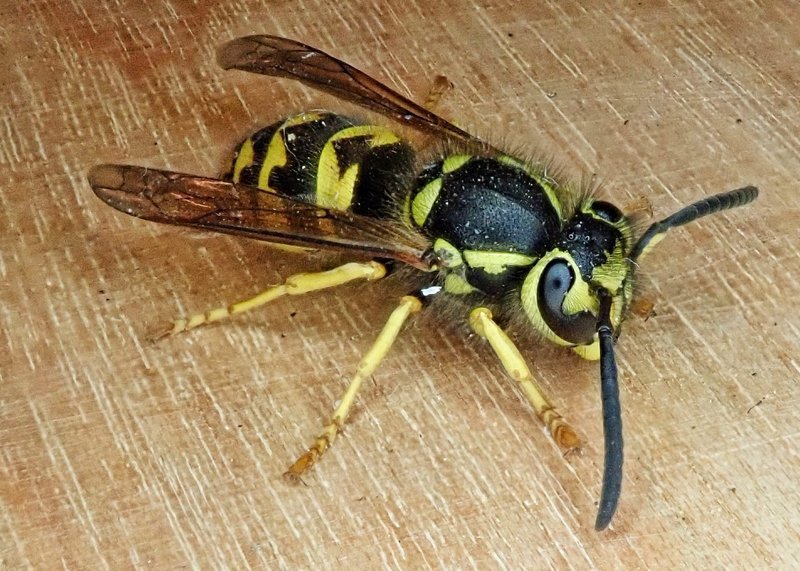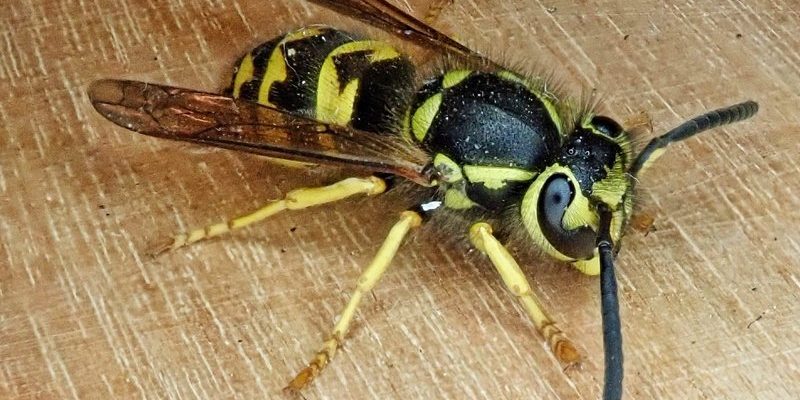
Yellowjackets are fascinating creatures that often get a bad rap. These wasps have a reputation for being aggressive, particularly in late summer and early fall when their populations swell. But there’s more to yellowjackets than their sharp stingers. They belong to the family Vespidae and are known for their striking black-and-yellow coloring, which serves as a warning to potential predators. With around 30 species in the United States alone, yellowjackets can be found in various habitats, but they particularly thrive in areas with ample food resources.
What sets yellowjackets apart from other wasps is their social behavior. They build nests in various locations, like trees, shrubs, and even underground. As a result, they often come into contact with humans, especially during summer picnics. If you’ve ever tried to enjoy a meal outside only to be bombarded by these buzzing pests, you’re not alone. Their ability to scavenger can lead them to human food sources, which is why they are often seen buzzing around our outdoor gatherings.
Understanding yellowjackets helps us navigate our interactions with them. They play essential roles in the ecosystem, such as pollination and controlling pest populations. Yet, their aggressive tendencies make learning about them crucial for staying safe while enjoying nature.
Physical Characteristics of Yellowjackets
Yellowjackets have some unique features that help identify them easily. They typically range from 0.5 to 0.75 inches in length. Their smooth bodies are adorned with bright yellow and black stripes, which can vary slightly depending on the species. This bold coloring not only makes them easy to spot but also serves as a form of protection. Predators often avoid them due to the association of their colors with painful stings.
Aside from appearance, yellowjackets have distinctive wing structures. They possess two pairs of wings that are folded lengthwise when at rest, giving them a sleek look. Their body structure is designed for agility, allowing them to dart around quickly. You might notice their fast, buzzing flight as they hover around food sources, drawing attention to themselves.
Interestingly, yellowjackets possess very powerful mandibles that they use for various tasks, from chewing through food to constructing their nests. This physical ability is vital for their survival and their role as scavengers in the ecosystem.
Habitat and Nesting
Yellowjackets are adaptable insects that can thrive in various habitats, from forests to urban areas. They prefer places with abundant food sources, like garbage cans and picnics, which is why you might find them buzzing around outdoor events. Their nests are often built in protected areas, such as in the ground, inside hollow trees, or even in the walls of buildings.
These nests are constructed from chewed wood fibers mixed with their saliva, creating a paper-like material. A single nest can house hundreds to thousands of yellowjackets, making them quite a formidable presence when disturbed. The nesting season usually begins in the spring, when queens emerge from hibernation to establish new colonies. By late summer, the nests can become overcrowded, which often leads to increased aggression among the wasps.
Due to their nesting habits, yellowjackets might invade human spaces, becoming a nuisance at barbecues or outdoor gatherings. Knowing where to look for their nests can help you avoid potential encounters. It’s essential to be cautious around known nesting sites to minimize the risk of getting stung.
Diet and Feeding Habits
Yellowjackets are opportunistic feeders, which means they’ll eat almost anything they can find. Their diet primarily consists of proteins, sugars, and carbohydrates. In their natural habitat, they hunt other insects, which provide essential protein for their growing larvae. This makes them beneficial for pest control, as they help keep insect populations in check.
During the late summer months, the diet of yellowjackets shifts more toward sugary foods. This is when they become a common sight at picnics and outdoor events, attracted by sweet drinks and foods. You might find them hovering around your soda can or trying to snag a piece of cake. While their scavenging behavior can be annoying, it’s essential for their survival as they prepare for the colder months ahead.
Interestingly, yellowjackets can also feed on plant nectar, which aids in pollination. This dual diet makes them quite versatile in their feeding habits. However, if you’re outdoors, it’s wise to keep your food covered, as these wasps will not hesitate to steal a bite if given the chance!
| Characteristic | Details |
| Size | About 0.5 to 0.75 inches in length |
| Color | Bright yellow and black striped body |
| Habitat | Forests, urban areas, and underground nests |
| Diet | Protein from insects and sugars from fruits and human food |
| Social Structure | Live in colonies, with a queen and several workers |
| Aggression | More aggressive in late summer and fall |
Behavior and Social Structure
Yellowjackets are social insects, living in colonies that can range from a few dozen to several thousand members. Each colony has a queen, female workers, and male drones. The queen is responsible for laying eggs, while the workers take care of foraging, nest maintenance, and protecting the colony. This division of labor allows yellowjackets to thrive in their environments.
One interesting aspect of yellowjacket behavior is their communication. They use pheromones, which are chemical signals, to convey messages to each other. For example, if a yellowjacket feels threatened, it can release a specific pheromone that alerts other workers to come and defend the nest. This instinctual and collective response underscores their social nature and ability to work together.
However, this social structure comes with challenges. As the season progresses, food becomes scarce, and competition for resources increases. This often leads to heightened aggression, especially as the colony prepares for winter. You might notice more yellowjackets buzzing around your outdoor gatherings during this time, driven by their survival instincts.
Interaction with Humans
The relationship between yellowjackets and humans can be quite complicated. While they play beneficial roles in the ecosystem, their aggressive behavior can lead to unwanted encounters. Many people have experienced the fear of getting stung while eating outdoors or working in the garden. Unfortunately, yellowjackets can become quite bold when searching for food, making it imperative to be cautious around them.
Stings from yellowjackets can be painful and, for some people, lead to allergic reactions. It’s essential to understand that they usually only sting when they feel threatened or if their nest is disturbed. Keeping a safe distance from their nests and avoiding swatting at them can help reduce the chances of a sting.
To coexist peacefully with yellowjackets, you can take a few simple steps. Cover food and drinks during outdoor activities, avoid wearing bright colors and floral patterns, and be mindful of their nesting sites. By respecting their space, you can enjoy your outdoor moments with less worry about these buzzing insects.
How to Deal with Yellowjackets
If you find yellowjackets invading your outdoor space, there are several strategies to manage them. First, prevention is key. Covering food and drinks is one of the simplest ways to keep them at bay. Using sealed containers or keeping food indoors until it’s time to eat can help minimize their attraction to your gathering.
If you notice a nest on your property, it’s essential to approach it with caution. Attempting to remove a yellowjacket nest during the day can be risky, as they are most active then. It’s often safer to deal with nests in the evening when the wasps are less active. If you’re unsure, consider hiring a pest control professional who can safely remove the nest without putting you or your family at risk.
For those who do get stung, treating the area promptly can help alleviate pain and swelling. Clean the sting area with soap and water, apply a cold compress, and consider taking an antihistamine if you experience discomfort. Watch for signs of allergic reactions, such as difficulty breathing or swelling in other areas, and seek medical help if necessary.
FAQ
What time of year are yellowjackets most active?
Yellowjackets are typically most active during late summer and early fall. This is when the colonies reach their peak size, leading to increased foraging behavior as they search for food and resources to sustain their growing numbers. As the weather cools down in the fall, their activity decreases, especially when temperatures drop significantly.
Do yellowjackets die in winter?
Yes, yellowjackets generally do die in winter. Only the fertilized queens survive the cold months by finding a sheltered spot to hibernate. The rest of the colony, including workers and males, dies off as the temperatures drop. In the spring, the queen emerges to start a new colony.
Are yellowjackets beneficial to the environment?
Absolutely! Yellowjackets play essential roles in the ecosystem. They help control pest populations by preying on insects and assist in pollination when they feed on nectar. Their scavenging habits also help clean up organic waste, making them valuable contributors to their environments.
How can I prevent yellowjackets from nesting in my yard?
To deter yellowjackets from nesting in your yard, keep your outdoor spaces clean by promptly disposing of trash and food remnants. Sealing holes and cracks in buildings can prevent them from nesting in walls. Additionally, monitoring for early signs of nests can help you address potential issues before they become significant infestations.
Can yellowjackets be beneficial for gardens?
Yes, yellowjackets can be beneficial for gardens! They help control pest populations by hunting insects that may harm your plants. Their role in pollination means they also contribute to plant health, making them a valuable ally in maintaining a thriving garden ecosystem.
What should I do if I get stung by a yellowjacket?
If you get stung, the first step is to stay calm. Remove any stinger if it’s still lodged in your skin, then clean the area with soap and water. Applying ice can reduce swelling and pain. Over-the-counter antihistamines may help alleviate discomfort, but seek medical attention if you experience severe allergic reactions, such as difficulty breathing.
Do yellowjackets attack without provocation?
While yellowjackets can be aggressive, they generally only attack when they feel threatened or their nest is disturbed. It’s important to avoid swatting at them or coming too close to their nests, as these actions can provoke a defensive response. Observing them from a safe distance is best to avoid unwanted interactions.
What attracts yellowjackets to my food at a picnic?
Yellowjackets are attracted to food that contains proteins and sugars. In particular, they have a keen interest in meats, sweet drinks, and desserts. If you’re having a picnic, keeping food covered and putting away unused items can help minimize the risk of attracting these persistent pests.
How can I tell if a nest is active?
An active yellowjacket nest will show frequent movement, with wasps flying in and out regularly. You may also see them foraging in nearby areas, particularly if there’s food around. If you spot a nest, it’s best to observe it from a safe distance to assess the level of activity.
Are there different types of yellowjackets?
Yes, there are several species of yellowjackets, each exhibiting different behaviors and habitat preferences. The most common species in the U.S. include the Eastern yellowjacket, Western yellowjacket, and the German yellowjacket, each named for their geographic distribution. While they share many characteristics, there may be variations in nesting habits and aggressiveness.
Can yellowjackets sting multiple times?
Unlike honeybees which leave their stinger behind and die after stinging, yellowjackets can sting multiple times. This means they can be quite aggressive if they feel their nest is under threat, leading to multiple stings in a short period. Avoid triggering their defensive responses to minimize the chances of being stung.

